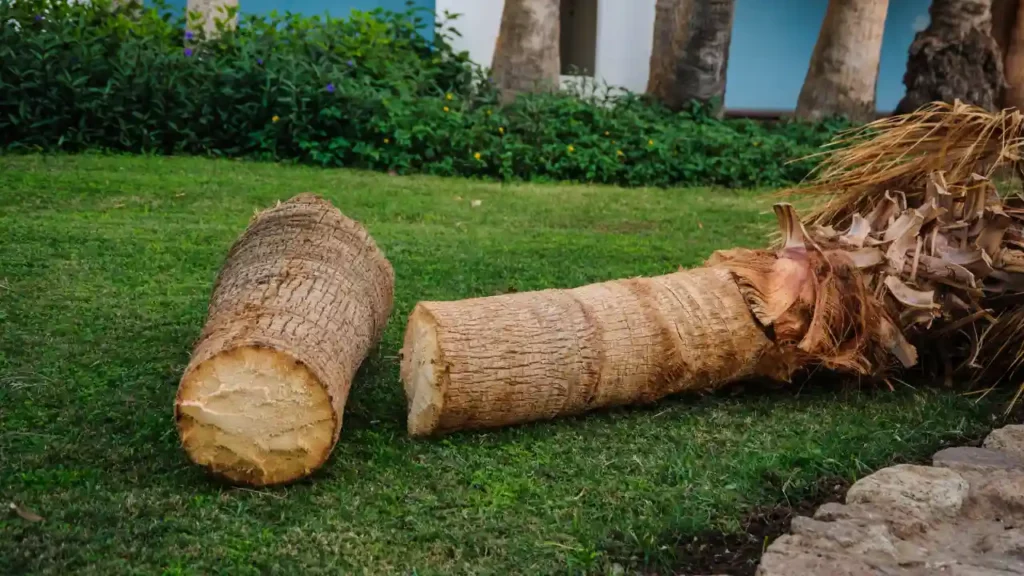You can safely remove palm trees if you know what you’re doing. Hiring a tree service to remove a palm tree is a good idea because of the potential harm it might pose to neighboring structures. You can dig up the tree’s roots and save them for replanting, or you can gently cut it down. While you are cutting a palm tree down, make sure it falls down without causing any accidents.

When you think about cutting down your palm tree, you might think of doing so without a chainsaw, as it’s not cheap to buy a powerful one that’s powerful enough to cut a palm tree down. Even the rental charge may be too much to bear if you don’t feel confident using power tools. A chainsaw is unnecessary to cut down a palm tree. These slim-trunked trees can be cut just as easily with a manual saw.
In this article, we will look into how you can cut a palm tree down with a chainsaw. But first, let’s see why you might need to cut down trees in the first place.
Reasons Why We Should Cut Down Trees
Getting rid of trees is something many people are hesitant to do. Tree cutting has been has a reputation of being bad for the environment, whether it’s one tree or a whole forest, but this isn’t always the case. There are many reasons you might get compelled to cut down a tree on your lawn or your landscape, and there are also reasons that can be beneficial. Here are some potential reasons for cutting down trees that might benefit you in the long run-
Aids in the Regrowth of Forests
Cutting down mature trees can help the development of new trees in other areas. Even though they may be great to look at, older trees in a forest often obstruct the growth of younger trees and other species. A forest’s growth, diversity, and development might suffer as a result of this.
Supports Ecological Variety
Taking down trees is different from clear-cutting. Get in touch with a tree service in your area to help you manage your forest and remove any problematic trees. The removal of a few trees has multiple benefits, including increased biodiversity and easier access to timber and other commodities.
The failure to cut down trees can threaten the homes of certain animal species. Many different kinds of ecosystems can be found in forests, and certain animals can survive there only if they are in a particularly young forest. To maintain a forest’s health and vitality for these creatures, it may be necessary to cut down trees and otherwise manage the forest selectively.
Decreases the Potential for Tree Failure
You may need to have a tree cut down if it’s blocking your path or posing any other kind of danger. This could be the case even with a single tree on your land. A dead tree’s structure is already damaged, so it’s just a matter of time before it falls over in the wind. Work with a local tree service provider for safe removal rather than waiting for nature to take its course, which could result in the tree falling on your house, car, or a person.
Produces New Energy Sources
Cutting down vast swaths of forests without replacing them is ecologically destructive. Cutting down trees and replacing them with new ones while being careful not to destroy important habitats for native wildlife provides a remarkable renewable resource that can be used for all of our industrial needs.
Helps Stop the Spread of Disease and Pests
Many pests and illnesses that affect trees cannot be eliminated or cured. The potential for a widespread infestation on your property and in your neighborhood can be reduced if you act quickly. Before a diseased or infested tree may spread to other trees or the rest of your property, it is better to have it removed.
The Process of Cutting Down a Palm Tree (Without Chainsaw)
Here are the best ways and the complete process that you can follow when you need to cut down a palm tree on your lawn, and that too without a chainsaw-
1. Fill out a Permit Application
The first thing you should do before attempting a DIY palm removal is to find out if a permit is required. Cities can no longer demand a permit to take down trees that pose a risk to persons or property because of a recent change in state law.
In any case, you can’t just conclude on your own that a palm has reached the point of no return. Having a professional arborist assess the risk is a must. If the palm is indeed hazardous, as determined by the arborist’s inspection, its removal can be accomplished without obtaining a license.
2. Ensure Reviewing Your Homeowner’s Insurance Plan
This is a crucial step if there is any risk that you will harm your house or roof when removing your palm. Any harm you cause by cutting down a palm tree is probably not covered by a standard homeowner’s insurance policy.
However, if you have comprehensive insurance, you might find that this sort of damage is covered. If you want to pull down the palm yourself, you should first verify that the damage will be covered by your insurance policy.
3. Prepare a Disposal Strategy
If you’re going to perform the removal yourself, plan out your waste disposal strategy first. When a palm tree is cut, a surprising quantity of biomass needs to be disposed of, so it’s smart to have a strategy in place. You can let your garden waste decompose over several years in a special area of your yard if your yard is sufficiently large.
4. Get the Proper Equipment
As a next step, gather all of the necessary tools. With a manual saw and some guy ropes, you might be able to remove a young palm tree from the ground. If that’s the case, you won’t need much more than this, plus a pair of sturdy shoes, gloves, and safety glasses. If, however, you have a more substantial palm, you’ll need to put together the following:
Tools:
- A saw
- Protective eyewear
- Gloves and a safety belt
- Sturdy Step Ladder
After gathering these supplies, you can go to work.
5. Pick Your Strategy for Cutting the Palm Tree
The first step in chopping down a palm is settling on a method that works for you. A cutting at the base may be an option if the palm is still young and there are no obstructions.
However, you should remove a wedge from the side where you want the palm to fall in order to have it fall in the desired direction. By removing a wedge from the palm’s south side, for instance, you can direct the tree’s trunk to fall south. It’s recommended that the wedge remains between a third and a quarter of the trunk’s diameter.
Once your blade gets close to the wedge cutout, take it slow. At this point, the trunk may start to drop on its own, even if you haven’t severed it through yet. If this occurs, refrain from cutting it any farther; the fall will be softer that way.
If you absolutely must make a clean cut to the wedge, do so with extreme caution at the end; the falling trunk could injure you if it springs backward. If your palm is too big to cut in one piece from the bottom up, you’ll need to top it off and then remove the trunk portions. Now, let’s check out the procedure.
6. Cut Back the Branches
When your palm tree is too large to be cut in one piece, frond removal is the first step. Keep in mind that you can do the same thing if you plan on cutting the palm down to the ground but wish to slow the rate at which its leaves fall.
Palm trees, and the fronds on them, are easy to prune (though also slightly hazardous). Start by securing your ladder to the trunk’s underside. The fronds can then be removed one by one using a hand-held tree saw. Cut only the fronds that aren’t immediately above you. Switch the location of your ladder so that you and it won’t be hit by any falling palm fronds.
7. Break the Tree Into Sections
Once the fronds have been removed, you can begin chopping away at the trunk. To lessen the potential for injury, you should only chop off a part no longer than your arm’s length at a time.
Proceed with caution, as this is a crucial job. You and your ladder could easily fall to the ground if the falling tree trunk pieces strike it. Carefully arrange your ladder and work with caution to avoid any mishaps.
8. Taking Off the Bottom of the Trunk
Removing the base of your palm tree comes after cutting down the trunk. Some people prefer to keep the base and use it as a stool or plant stand. Renting a stump grinder is the best option if you wish to get it removed. It’s possible to remove a palm tree stump by letting it decay away, but a stump grinder is far more efficient.
9. Get Rid of the Garbage
After you have cut down your palm tree, the final step is to get rid of the debris. We have already established that you can either let it degrade on your property or have it hauled away.
It’s also possible to hire a chipping service to reduce the size of the biomass, though this will depend on the thickness of your palm’s trunk. It will break down more rapidly in a compost bin as a result of this. As an alternative, you can use the chippings as mulch in your garden.
Hiring a Professional Tree Service
Removing a palm taller than your head poses a significant risk to yourself and others. So, getting professional help is better if you’re dealing with anything other than a young and short palm. We’ve seen firsthand what happens when people try to remove trees without the proper safety gear and training, which is why our company only employs certified arborists. It is easier and safer to hire a professional tree service. The safest method for removing a palm tree is to use the services of a professional tree removal company.
In addition to being less risky for you personally, it also poses less of a threat to your possessions. Tree removal can be expensive if something goes wrong and your homeowner’s insurance doesn’t cover the cost. Also, if you choose a reputable tree removal service, they will send out arborists to assess your trees and let you know if any permits are required, as well as whether or not any diseases, such as palm tree trunk rot, are present.
Last but not least, the debris left behind will be cleaned up by the tree removal service.
Final Words
You can cut your palm tree safely and effectively by following the abovementioned procedure, and that too without a chainsaw. You can go through the measures one by one to successfully complete the task. Make sure to take proper safety precautions before getting to work. However, the instruments and the job are just as risky. If you’re not confident you can do the task properly, make sure to get professional help and hire an arborist.
